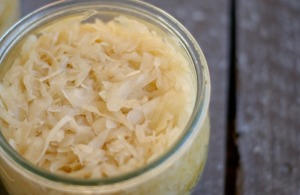Improve Your Gut, Improve Your Immune System! Gut Healthy Recipe
Your gut is the main area in the body where the immune system interacts with what’s brought in from the outside world. Signals from natural intestinal bacteria are necessary for an effective immune response to various viral or bacterial germs. So in times of stress, or reduced immune, take a quality probiotic, but you can support your digestion and immunity with foods, also.
Fermented foods are loaded with probiotics to keep the good bacteria in your gut happy and in balance. I use this recipe from Detoxinista, it’s super simple and quite tasty! Just try a few forkfuls a day for improved gut health, and improved immune health!
Homemade Raw Sauerkraut
- 1 head green or purple cabbage
- 2 Tablespoons sea salt
- Spring or distilled water, as needed
- Start with really clean tools. Sanitize your jar, knife, cutting board, tongs and glass bowl with boiling water, which should kill off any lurking bad bacteria. We only want the good kind growing in our veggies!
- Rinse cabbage well, and remove the large outer leaves. (You’ll want to save these for later.)
- Using a sharp knife, shred the cabbage and transfer it to a large glass bowl. Add about 2 Tablespoons of salt, then, using tongs or clean hands, massage the cabbage until it starts to break down from the salt. It will release moisture and reduce in size.
- Transfer the massaged cabbage to a clean glass jar, preferably one that is large enough to fit your hand through the top. The most important part of making fermented veggies is that you remove all the air in the jar– so you want to pack the cabbage tightly, leaving no gaps! I used my fist to punch it down, but a clean wooden spoon would work, too.
- While there is already plenty of moisture released from the cabbage to make the brine, I like to add a little extra spring water (do not use tap water!!) to make sure the liquid level is completely ABOVE the shredded cabbage.
- Once you’ve added the water, use the reserved cabbage leaves to press down the shredded cabbage– keeping it submerged under the liquid.
- Ideally, you’d fill up the jar all the way to the top, but mine didn’t work out that way. If that’s the case for you, too, simply fill a plastic bag with salt water (in case it bursts in the jar, you want it to be salt water!) to use as a “weight.” Place the salt water bag on top of the large cabbage leaf layer, and seal the jar. You should be able to see the liquid layer above the shredded cabbage line.
- Store the sealed jar in an insulated bag for 3-7 days. You can start checking on it after 3 days, just make sure the liquid level is high enough each time you re-seal the jar!
- Once the sauerkraut has fermented to your liking, remove the weight and outer leaves and discard. Note: It’s not uncommon for a layer of mold to develop on the outer leaves. This doesn’t mean your sauerkraut is ruined! Simply discard the layer of mold, and everything underneath the brine should be safe. As always, use your best judgement– if it smells off, don’t eat it.
- Store in the fridge and enjoy! The sauerkraut will last for months in the fridge, so feel free to make a BIG batch!
Once you’re comfortable making your own sauerkraut, feel free to get creative with the veggies you add to it! Ginger, beets, carrots, garlic, and lemon juice all make tasty additions.

